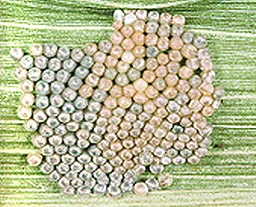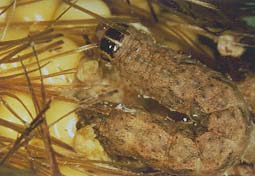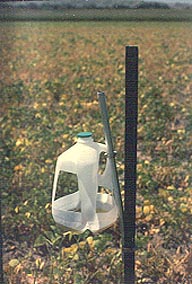by F.B. Peairs* (10/14)
Quick Facts…
- The western bean cutworm passes through five developmental stages – egg, larva, prepupa, pupa, and adult (moth).
- Infestations averaging several larvae per ear can result in the reduction of grain yield by as much as 30 to 40 percent.
- Larvae from a single egg mass may infest nearby bean plants within a 10 to 12 foot circle.
- Some naturally occurring biological controls, including birds, insect predators, and pathogens have been observed in the field.
Western bean cutworm, Striacosta albicosta (Smith), has been a pest of dry beans for many years. More recently it has been recognized as a serious pest of dryland and irrigated field corn in northeastern Colorado.
Description
The western bean cutworm passes through five developmental stages – egg, larva, prepupa, pupa, and adult (moth). The dome-shaped eggs, which are slightly larger than the head of a common pin, are laid in flat, irregularly shaped masses (Figure 1.), usually ranging from 15 to 50 eggs per mass. When first laid, eggs are white with a thin, red ring around the top. Eggs darken with age, first to brown and then to purple or black just before hatch.

Figure 1: Western bean cutworm egg mass. (Photo by F.B. Peairs) |

Figure 2: Western bean cutworm larva. (Photo by F.B. Peairs) |

Figure 3: Western bean cutworm adult. (Photo by J.L. Capinera). |

Figure 4: Western bean cutworm damaged pods (left) and seeds (lower right). (Photo by H.F. Schwartz). |
Young western bean cutworm larvae are dark brown with faint diamond-shaped markings on their backs. They lighten in color as they mature and are gray to pinkish brown when fully grown. Mature larvae (Figure 2.) are about 1 1/2 inches in length and have three short dark stripes running lengthwise on the first segment behind the head. The stripes behind the head can be used to distinguish western bean cutworm larvae from corn earworm larvae, which also are found feeding in ear tips. The prepupae and pupae occur in the soil and are rarely seen.
The body of the adult (Figure 3.) is about 3/4 inch long and brown in color. These moths have a wingspan of about 1 1/2 inches and are marked with creamy white stripes on the leading edge of the forewings. A white spot is found just behind and about half way along the white stripe, and a kidney-shaped spot is located near the end of the stripe. The light-colored hind wings are not distinctly marked.
Life History
Western bean cutworms complete a single generation each year. Fully-grown, nonfeeding larvae (prepupae) overwinter in the soil in earthen cells found at depths of three to nine inches. Pupation occurs in May and early June. The moths emerge between mid-July and early August. They are active at night and are attracted to lights. Eggs are laid shortly after the moths emerge. Egg masses are deposited on the top surface of upper leaves of corn or on the undersides of bean leaves. The eggs hatch in five to seven days. The majority of western bean cutworms feed until mid-September. Mature larvae enter the soil and construct the overwintering cells for the prepupal stage.
Damage: Corn
Western bean cutworm eggs are laid in the upper third of the corn plant, on the upper sides of the leaves. In erect leaf varieties eggs are commonly found on lower leaf surfaces as well. Newly hatched western bean cutworms move to one of two places on the corn plant, depending on the stage of development of the corn. If corn has not tasseled, larvae feed on pollen in the developing tassel within the flag leaf. If corn has tasseled, larvae feed on silk in the ear. If silk feeding persists during pollen shed, pollination may be poor. Plant to plant movement is common and larvae from a single egg mass may infest nearby plants within a six to 10 foot circle.
Once the ear has formed, it becomes the major feeding site for western bean cutworms, which feed on developing kernels. They reach the kernels through the silk channel or by chewing through the husks. Infestations averaging one cutworm per ear result in a loss of about four bushels per acre. Infestations averaging several larvae per ear can result in the reduction of grain yield by as much as 30 to 40 percent. Yield reduction in silage corn usually is not as severe, but kernel loss may result in reduced ensilage quality.
Damage: Dry Beans
Western bean cutworm moths lay their eggs on the undersides of dry bean leaves. Larvae from a single egg mass may infest nearby plants within a 10 to 12 foot circle. Young larvae feed on tender leaves and flower parts, causing little noticeable damage. Economic damage occurs when larvae chew through pod walls and feed on developing seeds (Figure 4.). Feeding activity is mostly nocturnal or on cloudy days. Larvae hide in the soil at the base of bean plants during sunny periods. Yield losses of eight to 10 percent due to western bean cutworm feeding have been estimated.
Management
Few effective alternatives to chemical control currently are available. Tillage has been suggested, but not tested. Some naturally occurring biological controls including birds, insect predators, and pathogens have been observed in the field. Some resistance is available in dry beans, but not in acceptable varieties. Bt corn hybrids containing Viptera events are labeled for control of western bean cutworm, however, the other available events will not be effective against this pest.
Properly timed insecticide treatments based currently accepted economic guidelines remain the only highly effective means of control in both corn and dry bean. Both aerially applied and chemigated treatments have been effective in university tests.
| Currently labeled insecticide products are given in the High Plains Integrated Pest Management Guide. |
Treatment Guidelines: Corn
Western bean cutworm eggs are laid on upper leaf surfaces on the upper part of the plant. Fields should be scouted closely because once the larvae move into the ear, controlling them will be difficult. Look for eggs and larvae on upper leaf surfaces in the upper third of the plant. Prior to pollen shed, tassels should be inspected for larvae. Check 10 consecutive plants at several locations (at least five) per field, using enough locations so that all areas of the field are represented.
Chemical control should prove economical if at least eight percent of the plants have egg masses or small larvae. If most eggs are hatched, treat when the crop is at least 95 percent tasseled and before the larvae have started to feed on the silks. If most eggs have not hatched and the crop is completely tasseled, then treat when most eggs have reached the purple stage.
Treatment Guidelines: Dry Beans
Scout adjacent corn, where it is much easier to find eggs and larvae, because beans are likely to be infested and require treatment if nearby corn is infested. Direct treatment decisions in dry beans can be based on larval counts, light trap catches or pheromone trap catches. Larval counts are difficult to obtain in dry beans because of crop growth habit and the insect’s habit of hiding in the soil during the day. Treat irrigated dry beans if two or more larvae are found per row foot prior to the onset of pod damage. Use a guideline of one western bean cutworm per row foot in dryland production systems.

Figure 5: “Milk jug” pheromone trap. (Photo by G.L. Hein) |
Light traps and pheromone traps are used to monitor adult activity and provide useful information on the need for and timing of insecticide treatments. While both traps provide similar information, pheromone traps are cheaper, simpler to operate, and more efficient. Also treatment decisions in dry beans can be based on pheromone “trap catches”, as described below.
Treatment Guidelines Based on Pheromone Trap Catches
- Material
-
- A. Scentry™ pheromone lures (www.scentry.com)
- B. Milk jug traps (Figure 5.)
- C. 4:1 mixture of water and antifreeze plus several drops of dish soap
- D. Data sheets
- Procedures
-
- A. Place two traps per field in late June or early July.
-
-
- i. Place traps on opposite sides of the field.
- ii. Best locations are bean field borders near dense vegetation.
- iii. Pin lure to lid of milk jug.
- iv. Place trap on a post at about four foot high.
- v. Fill base of trap with antifreeze mixture.
-
-
- B. Monitor weekly until peak flight, then at least three times per week until catches start to decline in early August.
- C. At each visit, using a small sieve to remove moths, count and record catch. Replenish antifreeze mixture.
- D.When average moth catch per trap starts to decline, determine:
-
-
- i. The date of peak capture.
- ii. The total number of moths caught per trap for the season through the date of peak capture.
-
- Treatment guidelines based on the average catch of the two traps per field from the beginning of the flight through the peak capture date are as follows:
-
- A. If fewer than 700 moths were caught then the risk of significant western bean cutworm damage is low.
- B. Catches between 700 and 1000 moths indicate low to moderate risk. Consider treatment if there is substantial activity in adjacent corn fields; or pod feeding is noted about three weeks after peak flight.
- C. Catches of more than 1000 moths indicate high risk. Risk goes up as trap catches increase above this level. Risk can be confirmed by scouting adjacent corn and by checking for pod damage.
- Treatments are most effective if applied 10 to 20 days after peak flight. This allows time for all eggs to hatch, but is early enough to avoid damage
from large larvae.
* F.B.Peairs, Colorado State University Extension entomologist and professor of entomology, bioagricultural sciences and pest management. 6/02. Revised 10/14.
Colorado State University, U.S. Department of Agriculture and Colorado counties cooperating. CSU Extension programs are available to all without discrimination. No endorsement of products mentioned is intended nor is criticism implied of products not mentioned.
Go to top of this page.





